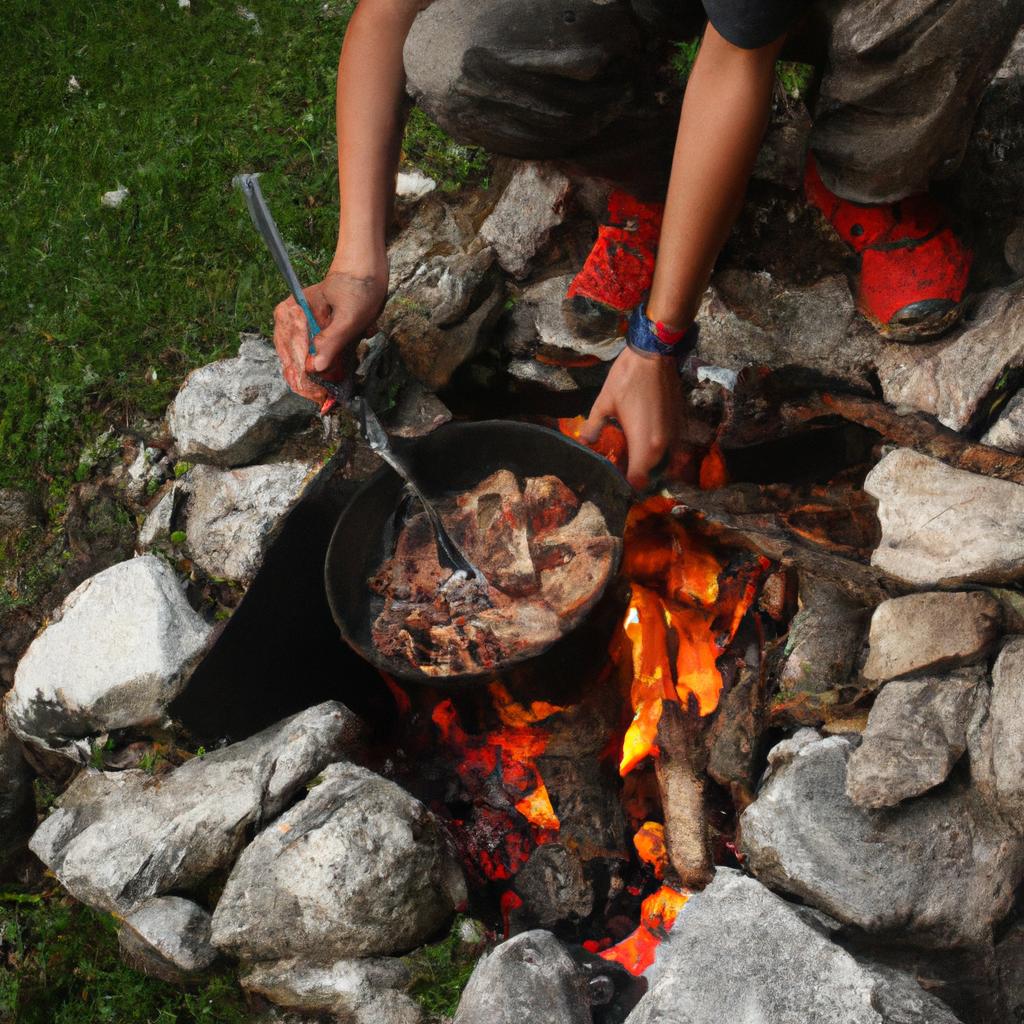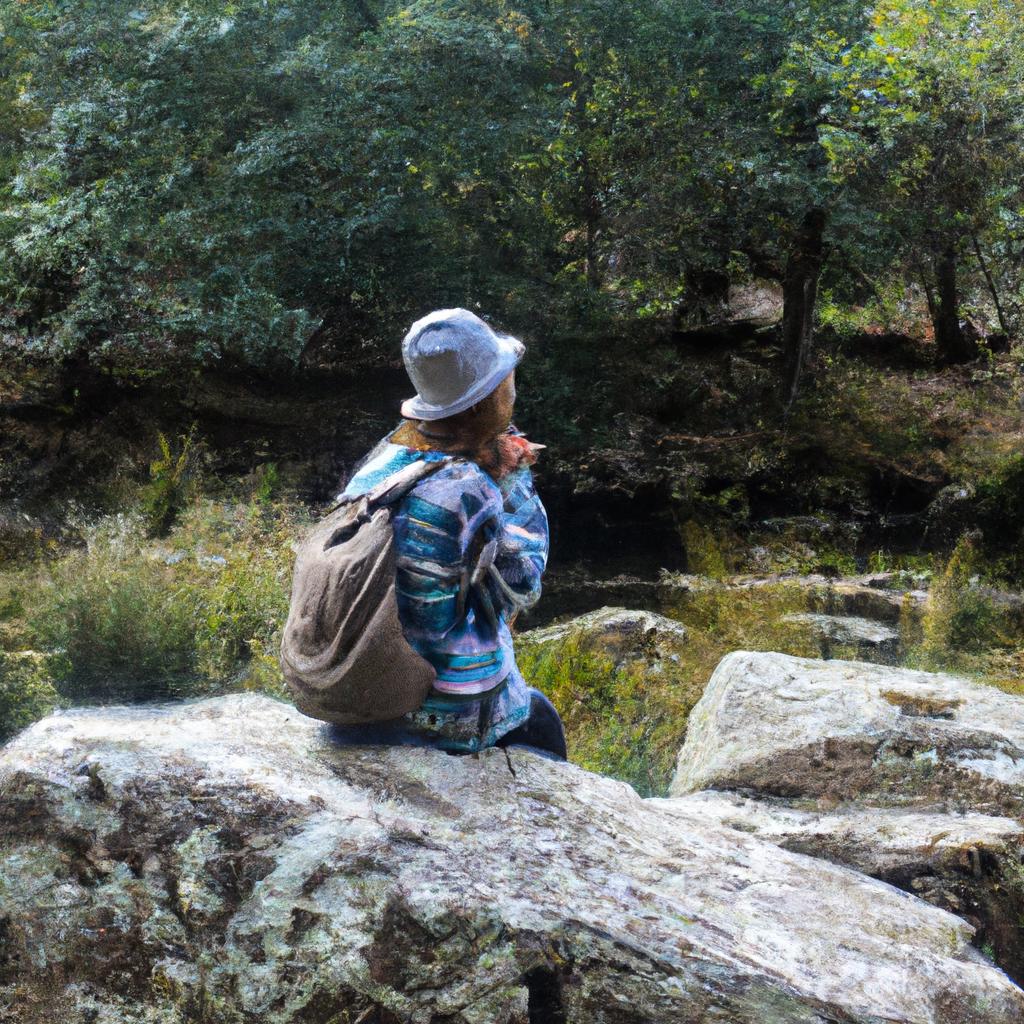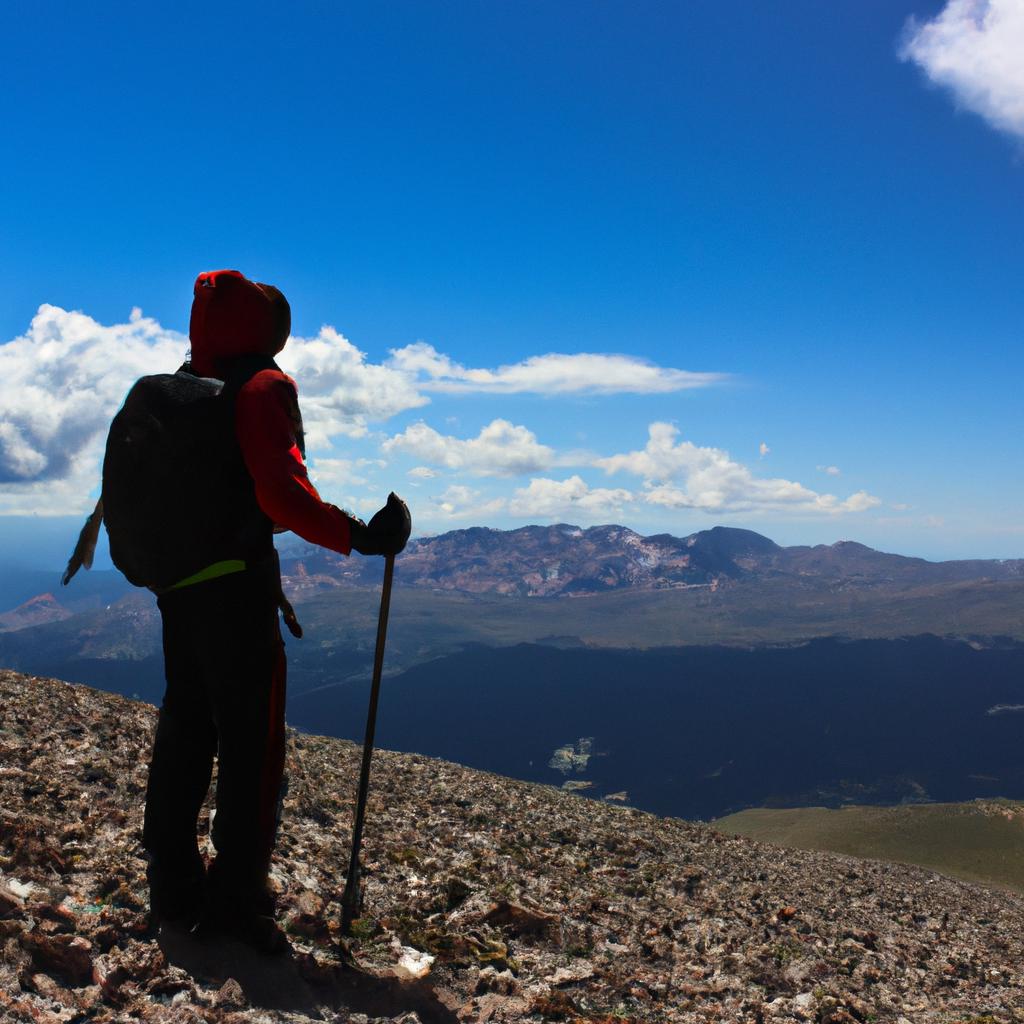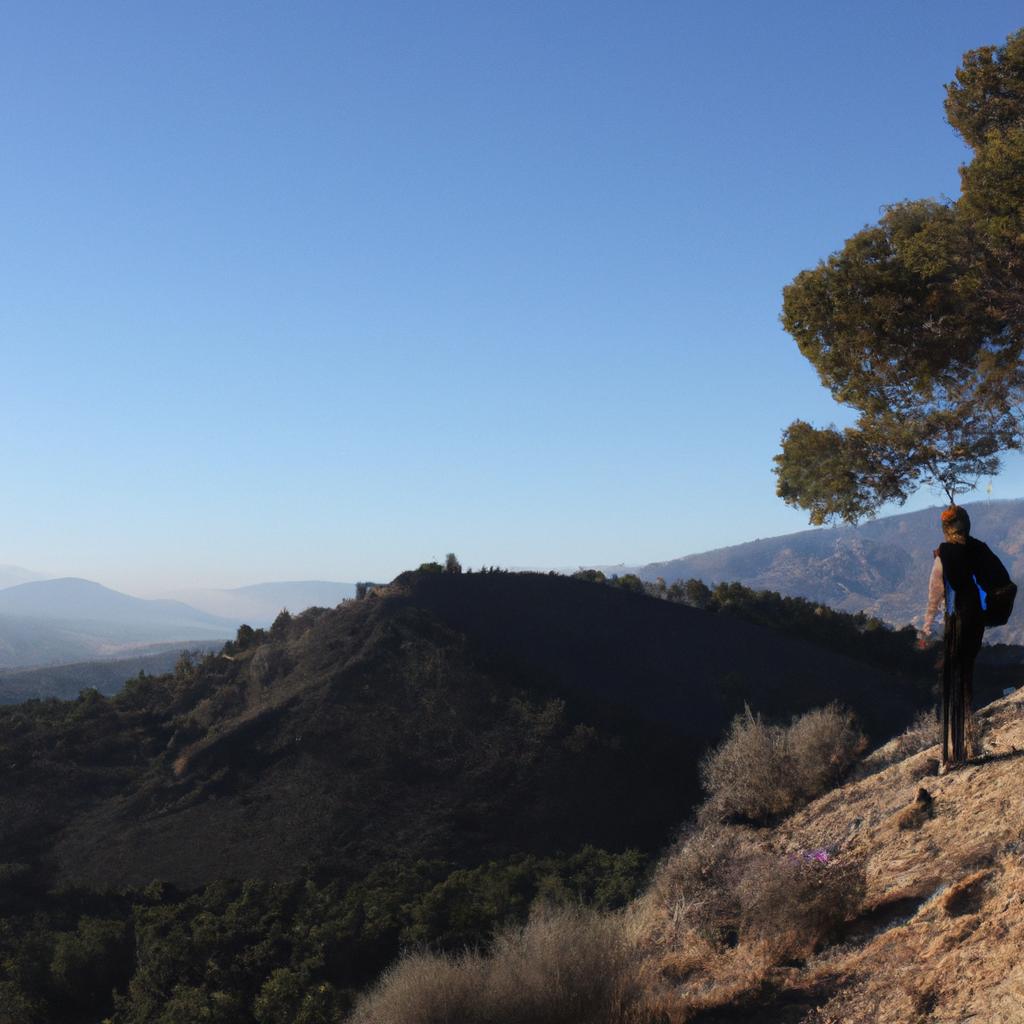Campfire cooking has long been a cherished tradition among hiking and camping enthusiasts. The crackling flames, the aromatic scents wafting through the air, and the sizzling sounds of food being prepared over an open fire evoke a sense of nostalgia and adventure. Whether it is roasting marshmallows for gooey s’mores or grilling fresh catch from a day of fishing, campfire cooking offers a unique culinary experience that cannot be replicated in conventional kitchens.
Consider Sarah, an avid hiker who embarked on a week-long trek across rugged terrains. As she ventured deeper into the wilderness, her reliance on modern amenities diminished, leaving her with only basic tools to survive. With limited resources at hand, Sarah discovered the art of campfire cooking as both practical and rewarding. By utilizing simple techniques such as foil-wrapping and skewering, she was able to prepare delicious meals using ingredients found in nature’s pantry. This newfound skill not only nourished her body but also fueled her spirit, allowing her to fully embrace the beauty and serenity of her surroundings.
Choosing the Right Cooking Equipment
Imagine embarking on a hiking or camping trip in the great outdoors. The sun is setting, and you find yourself surrounded by nature’s beauty as you set up camp for the night. As hunger strikes, you gather around the flickering flames of your campfire to prepare a delicious meal. However, without the proper cooking equipment, this idyllic scene can quickly turn into a frustrating experience.
To ensure successful campfire cooking, it is essential to select the right tools for the job. Here are some factors to consider when choosing your cooking equipment:
- Durability: Opt for sturdy materials such as stainless steel or cast iron that can withstand outdoor conditions and rough handling.
- Versatility: Look for multi-purpose utensils that serve different functions to minimize space and weight in your backpack.
- Portability: Consider lightweight options that are easy to carry during long hikes or while navigating challenging terrains.
- Ease of cleaning: Choose cookware with non-stick surfaces or detachable parts that facilitate effortless cleaning even in limited water resources.
By prioritizing these factors, you can enhance your camping experience by having efficient and reliable cooking equipment at hand.
| Durability | Versatility | Portability | Ease of Cleaning |
|---|---|---|---|
| Stainless Steel Cookware | Multi-tool Utensils | Compact Camping Stove | Non-Stick Grill Pan |
| Cast Iron Dutch Oven | Collapsible Silicone Bowls | Lightweight Mess Kit | Detachable Pot Handles |
| Titanium Sporks | Folding Camp Grills | Portable Coffee Makers | Easy-to-Clean Cooking Surfaces |
As you embark on your next adventure, selecting suitable cooking equipment will allow you to immerse yourself fully in nature while enjoying flavorful meals prepared over an open fire. In doing so, not only will you satisfy your hunger, but you will also create lasting memories around the campfire.
Transitioning into the subsequent section about “Selecting the Best Campfire Cooking Recipes,” it is important to consider how these recipes can complement and maximize the potential of your chosen cooking equipment. By pairing the right tools with delicious recipes, you can elevate your camping experience from mere sustenance to a culinary adventure in nature’s embrace.
Selecting the Best Campfire Cooking Recipes
Section H2: Choosing the Right Cooking Equipment
With the appropriate cooking equipment at hand, let us now delve into the exciting world of selecting the best campfire cooking recipes.
Section H2: Selecting the Best Campfire Cooking Recipes
Imagine yourself sitting around a crackling campfire after a long day of hiking and camping. The aroma of delicious food fills the air as you gather with friends or family to enjoy a hearty meal under the starry sky. In this section, we will explore how to choose the best campfire cooking recipes that not only satiate your hunger but also enhance your outdoor experience.
-
Consider simplicity and convenience:
When it comes to outdoor cooking, simplicity is key. Opt for recipes that require minimal preparation and ingredients while still offering maximum flavor. For instance, one popular recipe among hikers is foil packet meals. By wrapping various ingredients in aluminum foil and placing them directly on hot coals or grill grates, you can create delectable dishes without much hassle. -
Embrace variety:
To keep things interesting during your outdoor adventures, embrace recipe diversity. Explore different cuisines and experiment with unique flavors to add excitement to your meals by incorporating international spices or local produce from nearby towns into traditional camping staples like grilled meats or roasted vegetables. -
Prioritize nutritional value:
Maintaining proper nutrition while camping is crucial for energy levels and overall well-being. Ensure your chosen recipes provide essential nutrients through a balanced combination of proteins, carbohydrates, healthy fats, vitamins, and minerals. Include fresh fruits and vegetables whenever possible to boost both taste and health benefits. -
Cater to dietary restrictions:
Inclusivity is important when planning campfire meals since individuals may have specific dietary needs or restrictions such as vegetarianism, gluten intolerance, or allergies. Be mindful of these requirements when selecting recipes so that everyone can partake in a satisfying culinary experience together.
| Recipe | Description |
|---|---|
| Campfire Pizza Nachos | A mouthwatering combination of crispy tortilla chips, melted cheese, and flavorful toppings that can be customized to individual preferences. Perfect for sharing around the campfire! |
| Grilled Veggie Skewers | Colorful skewers loaded with marinated vegetables like zucchini, bell peppers, mushrooms, and cherry tomatoes. An excellent choice for vegetarians or those who want a lighter option. |
| Foil-Wrapped Sausage and Potatoes | A hearty one-packet meal consisting of sausages, potatoes, onions, and seasonings cooked together in foil packs over hot coals. It’s easy to prepare and requires minimal cleanup. |
| Dutch Oven Peach Cobbler | Indulge your sweet tooth with this classic dessert made by baking fresh peaches topped with a buttery crust right on top of charcoal briquettes or hot embers. |
Now that we’ve explored some enticing recipes for your outdoor cooking adventures, let us move on to essential food safety tips for ensuring a safe culinary experience amidst nature.
Section H2: Essential Food Safety Tips for Outdoor Cooking
Essential Food Safety Tips for Outdoor Cooking
Section H2: Essential Food Safety Tips for Outdoor Cooking
Having selected the best campfire cooking recipes, it is crucial to address the essential food safety tips for outdoor cooking. Ignoring proper food handling practices in a wilderness setting can result in unpleasant consequences that may jeopardize your camping experience. Let’s explore some key guidelines to ensure the safety of your meals while enjoying the great outdoors.
Example Scenario:
Imagine you are on a week-long hiking trip with friends. On the third day, one of your companions falls ill after consuming undercooked chicken cooked over an open fire. This unfortunate incident highlights the importance of prioritizing food safety when preparing meals during outdoor adventures.
Food Safety Tips:
To prevent such incidents and maintain hygiene standards, consider the following precautions:
- Keep perishable foods chilled: Properly store items like meat, dairy products, eggs, and leftovers in coolers or insulated bags with ice packs to keep them at a safe temperature.
- Separate raw and cooked foods: Avoid cross-contamination by using separate cutting boards, utensils, and plates for raw and cooked ingredients.
- Cook food thoroughly: Use a food thermometer to check if meats, poultry, fish, and other dishes have reached their recommended internal temperatures to eliminate harmful bacteria.
- Practice good hand hygiene: Always wash your hands before handling any food or touching surfaces that come into contact with edibles.
Table – Common Foodborne Illnesses:
| Illness | Symptoms | Prevention |
|---|---|---|
| Salmonellosis | Diarrhea, fever, abdominal cramps | Thoroughly cook eggs and poultry |
| Campylobacteriosis | Diarrhea (often bloody), stomach pain | Properly handle raw chicken |
| E.coli Infection | Severe diarrhea (sometimes bloody) | Avoid consuming undercooked ground beef |
| Listeriosis | Fever, muscle aches, nausea | Avoid unpasteurized dairy and deli meats |
By following these food safety tips and being aware of common foodborne illnesses associated with outdoor cooking, you can significantly reduce the risk of falling ill during your camping trip. With that in mind, let’s now shift our focus to vital tips for building and maintaining a campfire.
[End of section H2]
Tips for Building and Maintaining a Campfire
Section Title: Techniques for Cooking Over an Open Flame
Imagine this scenario: You’re out in the wilderness, surrounded by towering trees and the crackling of a campfire. As you gather around with your fellow outdoor enthusiasts, the aroma of food cooking over an open flame fills the air. Mastering the art of campfire cooking can truly elevate your hiking and camping experience. In this section, we will discuss some essential techniques to help you achieve delicious meals while embracing nature’s simplicity.
To begin with, one fundamental technique is using a grill grate or tripod system. These setups allow you to place pots, pans, or skewers directly above the fire for even heat distribution. By suspending your cookware at varying heights, you have better control over how quickly your food cooks. For example, when grilling vegetables on skewers, you might adjust their proximity to the flames based on desired tenderness.
Here are some key tips to keep in mind when cooking over an open flame:
- Use long-handled utensils to protect yourself from potential burns.
- Opt for cast iron cookware as it retains heat well and provides even cooking.
- Consider marinating meats before cooking to enhance flavor and tenderness.
- Keep a spray bottle filled with water nearby to extinguish any small flare-ups.
Now let’s take a look at a comparison table showcasing different methods of campfire cooking:
| Method | Pros | Cons |
|---|---|---|
| Skewering | Easy and versatile | Limited capacity |
| Foil packet | Retains moisture; no cleanup needed | Longer cooking time |
| Dutch oven | Ideal for slow-cooking | Heavy equipment |
| Campfire stove | Quick setup; adjustable temperature | Requires fuel supply |
By understanding these various techniques and considering factors such as available resources and personal preferences, you can tailor your campfire cooking experience to suit your needs.
In conclusion, mastering the art of cooking over an open flame can be a rewarding and enjoyable part of any hiking or camping trip. By using appropriate equipment and techniques, you can create delicious meals that satisfy both your hunger and desire for outdoor adventure.
Transitioning seamlessly into the subsequent section about “Techniques for Cooking Over an Open Flame,” let’s explore some mouthwatering recipes that are perfect for outdoor cooking.
Techniques for Cooking Over an Open Flame
Imagine this scenario: You and your friends have just finished setting up camp after a long day of hiking. As the sun begins to set, you gather around the crackling campfire, eagerly anticipating a delicious meal cooked over an open flame. Cooking food outdoors can be both satisfying and enjoyable, but it requires some knowledge and skill. In this section, we will explore various techniques that will help you master the art of cooking over an open flame.
One essential technique is using direct heat for quick-cooking foods like vegetables or thin cuts of meat. By placing these items directly on the grill grate or skewering them with metal skewers, they benefit from the intense heat produced by the flames. This method ensures that your food cooks evenly and develops those coveted charred flavors.
For slower-cooking dishes such as stews or roasts, indirect heat is key. To achieve this, create two zones in your fire pit or grill—one side with hot coals and flames, and another side without any direct contact with the fire. Place a cast-iron pot or Dutch oven on the cooler side while periodically adding more charcoal or wood to maintain a consistent temperature throughout cooking.
To enhance flavor and add variety to your outdoor meals, consider experimenting with different cooking methods:
- Foil packets: Wrap seasoned ingredients tightly in aluminum foil before placing them on the grill grates. This method allows for easy cleanup and helps retain moisture.
- Skillet cooking: Use a sturdy cast-iron skillet placed directly over the flames to cook everything from breakfast staples like scrambled eggs to sautéed veggies.
- Grilling planks: Soak wooden planks (such as cedar) in water before placing them on top of hot coals. The aromatic smoke infuses delicate flavors into fish fillets or even fruits like peaches or pineapple.
- Spit-roasting: If you’re feeling adventurous, try spit-roasting a whole chicken or a leg of lamb. This method requires patience and constant monitoring but yields succulent and evenly cooked meat.
Now that you have learned about different techniques for cooking over an open flame, let’s move on to the next section: Cleaning and Storing Cooking Equipment After Use. Keeping your cooking equipment clean and well-maintained is crucial for ensuring its longevity and preventing any potential foodborne illnesses.
Cleaning and Storing Cooking Equipment After Use
Transitioning from the previous section’s discussion on cooking techniques over an open flame, it is essential to now understand the importance of cleaning and storing your cooking equipment after use. Imagine this scenario: you have just enjoyed a hearty meal around the campfire with friends, but as darkness falls, you realize that cleaning up might not be so straightforward. Without proper knowledge and techniques for maintaining your cooking gear, you may find yourself facing unnecessary challenges during your next outdoor adventure.
To ensure longevity and efficiency of your camping cookware, here are some key points to consider:
- Thoroughly clean all utensils and dishes: Properly washing off food residue from pots, pans, plates, and cutlery is crucial to prevent any lingering smells or attracting unwanted wildlife. Using biodegradable soap or detergent along with warm water will help remove grease effectively without harming the environment.
- Scrubbing off stubborn stains: For tougher stains or burnt-on food particles, utilizing a non-abrasive scrub brush or sponge can aid in removing them without damaging the surface of your cookware.
- Drying before storage: Before packing away your kitchen essentials, make sure they are completely dry to avoid mold or rust formation. Towels or air-drying racks can assist in speeding up this process if needed.
- Organize and store properly: To keep everything easily accessible for future trips, consider investing in stackable containers or specialized bags designed for camping cookware storage. This way, you can efficiently utilize space while protecting fragile items from damage.
These simple steps go a long way towards ensuring that your cooking equipment remains clean, functional, and ready for future adventures in the great outdoors.
| Maintenance Tip | Description |
|---|---|
| Regular inspection | Check regularly for signs of wear-and-tear such as loose handles, cracks in enamel coating etc., which could compromise the integrity of your cookware. |
| Proper packing | Utilize padding or protective sleeves to safeguard delicate items such as mugs, glasses, and ceramic plates from breakage during transportation. |
| Environmental consideration | Dispose of wastewater responsibly by following Leave No Trace principles, ensuring that it is disposed of at least 200 feet away from any water source. |
| Seasonal maintenance | Before storing equipment for an extended period, conduct a thorough cleaning and check for signs of rust or corrosion. Apply appropriate treatments if necessary to prevent deterioration. |
In conclusion, taking the time to properly clean and store your camping cooking equipment after use not only promotes hygiene but also extends its lifespan. By implementing these straightforward practices into your routine, you can ensure that each outdoor culinary experience remains enjoyable and hassle-free.
Note: The transition statement may vary based on the content provided in the previous section.




